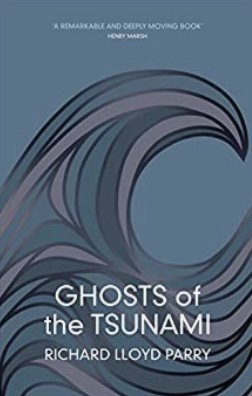Ghosts of the Tsunami by Richard Lloyd (MacMillan)
There are catastrophic events that are just too big for the human mind to absorb. On March 11, 2011 an earthquake hit Japan, the fourth most powerful ever recorded, measuring between 9 and 9.1 on the Richter Scale. It lasted for six interminable minutes, during which it knocked the earth ten inches off its axis, moved Japan four inches closer to Alaska’s Aleutian Islands, and generated a 120-foot tsunami that came less than an hour after the shaking stopped.
Japan is accustomed to earthquakes and its national protocols are firmly in place. Swiftly all the country’s highways, airports, and railways were shut down. Along the coast,tsunami warnings were broadcast. However in that crucial period between quake and wave, nobody knew exactly how strong the earthquake had been. Nor could they envision the size and power of the approaching tsunami.
When the wave struck, it caused a meltdown of three reactors in Fukishima’s nuclear power plants. The death toll measured 18,500 and half a million of the survivors were left homeless. Richard Lloyd Parry, who lived in Tokyo with his family, described the aftermath as a “disordered dream…like a huge and awkwardly shaped package without corners or handles.” Despite his years as an Asian-based journalist, he found that this story was almost impossible to convey in words. It wasn’t until he went to Okawa, a tiny river town on Japan’s northern coast, that the horror became imaginable.
Seventy-five children died in the tsunami. Seventy-four of them died in the schoolyard of the Okawa Elementary School, where they had proceeded in an orderly fashion once the school stopped shaking. With them were eleven teachers. Out of 108 students, only thirty-four children survived and just one teacher.
The school was located in front of a seven-hundred-foot hill. As parents dug their dead children out of the field of mud that the tsunami left behind, some began to wonder why the teachers hadn’t led their pupils up that hill. This issue became far more pointed when the timeframe was widely known. The earthquake was over by 2:46. The tsunami arrived at 3:37, pushing its way up the nearby river.
A parent who came immediately after the quake to pick up her daughter had urged the teachers to take the children up the hill. She was told that she was over-reacting. Two boys later made the same suggestion. They were ignored.
When the school’s emergency manual had been written, nobody thought of tsunamis as being a danger. The procedure recommended for one was almost criminally vague.
The national ability to accept earthquakes without panic leached into the reactions of the teachers at Okawa Elementary School and that, along with an ingrained deference toward authority figures, led to a tragedy that became a country-wide issue. But even as the facts slowly came to light, the parents of the dead children grew divided to the point of hatred. The ones who wanted justice through the courts were seen as betrayers of a national code of honor by the others. “Why lay blame,” asked one mother whose child didn’t survive, “What do you expect to come of it?”
By concentrating on one small area of Japan, Parry has made the disaster that wracked the entire country heartbreakingly comprehensible. Interviews with grieving parents, a student who survived, and a man who swam out of the wave through the front door of a friend’s house will make anyone who lives in a coastal community on a fault line begin their emergency planning while searching for the closest high ground.~Janet Brown
